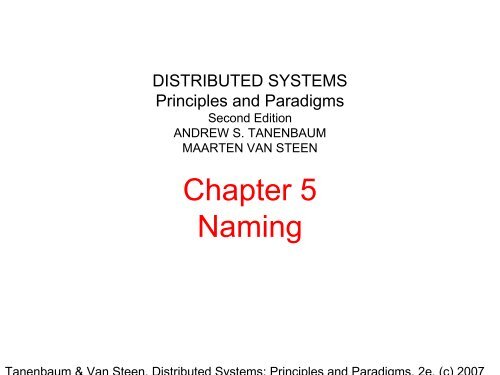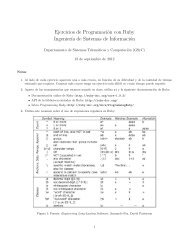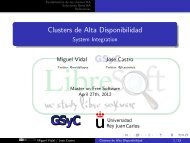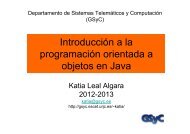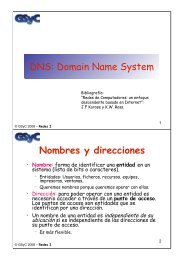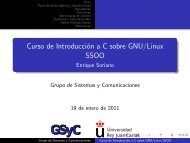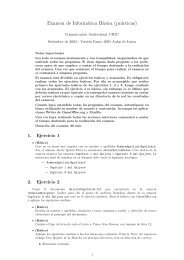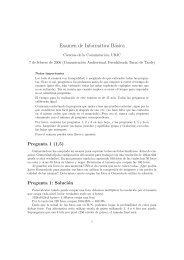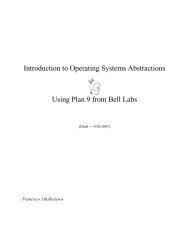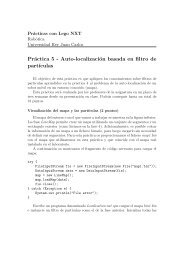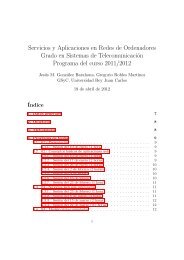Chapter 5 Naming - docencia de la ETSIT-URJC
Chapter 5 Naming - docencia de la ETSIT-URJC
Chapter 5 Naming - docencia de la ETSIT-URJC
You also want an ePaper? Increase the reach of your titles
YUMPU automatically turns print PDFs into web optimized ePapers that Google loves.
DISTRIBUTED SYSTEMSPrinciples and ParadigmsSecond EditionANDREW S. TANENBAUMMAARTEN VAN STEEN<strong>Chapter</strong> 5<strong>Naming</strong>
Names, I<strong>de</strong>ntifiers, And AddressesProperties of a true i<strong>de</strong>ntifier:• An i<strong>de</strong>ntifier refers to at most one entity.• Each entity is referred to by at most onei<strong>de</strong>ntifier.• An i<strong>de</strong>ntifier always refers to the sameentity
Forwarding Pointers (1)Figure 5-1. The principle of forwarding pointersusing (client stub, server stub) pairs.
Forwarding Pointers (2)Figure 5-2. Redirecting a forwarding pointer bystoring a shortcut in a client stub.
Forwarding Pointers (3)Figure 5-2. Redirecting a forwarding pointer bystoring a shortcut in a client stub.
Home-Based ApproachesFigure 5-3. The principle of Mobile IP.
Figure 5-4.Resolving key26 from no<strong>de</strong> 1and key 12 fromno<strong>de</strong> 28 in aChord system.Distributed Hash TablesGeneral Mechanism
Hierarchical Approaches (1)Figure 5-5. Hierarchical organization of a location service intodomains, each having an associated directory no<strong>de</strong>.
Hierarchical Approaches (2)Figure 5-6. An example of storing information of an entityhaving two addresses in different leaf domains.
Hierarchical Approaches (3)Figure 5-7. Looking up a location in a hierarchicallyorganized location service.
Hierarchical Approaches (4)Figure 5-8. (a) An insert request is forwar<strong>de</strong>d to thefirst no<strong>de</strong> that knows about entity E.
Hierarchical Approaches (5)Figure 5-8. (b) A chain of forwarding pointersto the leaf no<strong>de</strong> is created.
Name Spaces (1)Figure 5-9. A general naming graph with a single root no<strong>de</strong>.
Name Spaces (2)Figure 5-10. The general organization of the UNIX file systemimplementation on a logical disk of contiguous disk blocks.
Linking and Mounting (1)Figure 5-11. The concept of a symbolic linkexp<strong>la</strong>ined in a naming graph.
Linking and Mounting (2)Information required to mount a foreignname space in a distributed system• The name of an access protocol.• The name of the server.• The name of the mounting point in theforeign name space.
Linking and Mounting (3)Figure 5-12. Mounting remote name spacesthrough a specific access protocol.
Name Space Distribution (1)Figure 5-13. An example partitioning of the DNS name space,including Internet-accessible files, into three <strong>la</strong>yers.
Name Space Distribution (2)Figure 5-14. A comparison between name servers for implementing no<strong>de</strong>s from a <strong>la</strong>rgescalename space partitioned into a global <strong>la</strong>yer, an administrational<strong>la</strong>yer, and a managerial <strong>la</strong>yer.
Implementation of Name Resolution (1)Figure 5-15. The principle of iterative name resolution.
Implementation of Name Resolution (2)Figure 5-16. The principle of recursive name resolution.
Implementation of Name Resolution (3)Figure 5-17. Recursive name resolution of . Nameservers cache intermediate results for subsequent lookups.
Example: The Domain Name SystemFigure 5-18. The comparison between recursive and iterativename resolution with respect to communication costs.
The DNS Name SpaceFigure 5-19. The most important types of resource recordsforming the contents of no<strong>de</strong>s in the DNS name space.
DNS Implementation (1)Figure 5-20. An excerpt from the DNSdatabase for the zone cs.vu.nl.
DNS Implementation (2)Figure 5-20. An excerpt from the DNSdatabase for the zone cs.vu.nl.
DNS Implementation (3)Figure 5-21. Part of the <strong>de</strong>scription for the vu.nldomain which contains the cs.vu.nl domain.
Hierarchical Implementations: LDAP (1)Figure 5-22. A simple example of an LDAPdirectory entry using LDAP naming conventions.
Hierarchical Implementations: LDAP (2)Figure 5-23. (a) Part of a directory information tree.
Hierarchical Implementations: LDAP (3)Figure 5-23. (b) Two directory entrieshaving Host_Name as RDN.
Mapping to Distributed Hash Tables (1)Figure 5-24. (a) A general <strong>de</strong>scription of a resource.(b) Its representation as an AVTree.
Mapping to Distributed Hash Tables (2)Figure 5-25. (a) The resource <strong>de</strong>scription of a query.(b) Its representation as an AVTree.
Semantic Over<strong>la</strong>y NetworksFigure 5-26. Maintaining a semantic over<strong>la</strong>y through gossiping.


